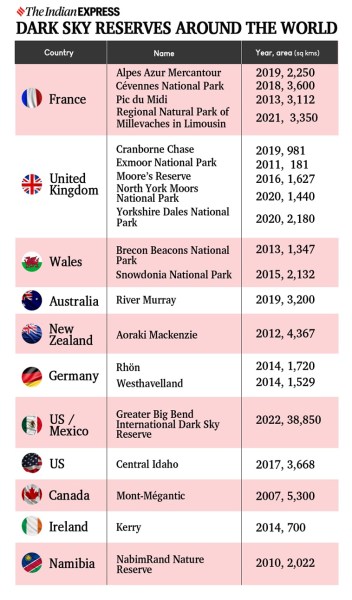Context
-
By the end of 2022, India will establish the country’s first Dark Sky Reserve as Hanle Dark Sky Reserve in the cold desert regions of Ladakh. This facility will also promote astronomy-tourism.
What is a Dark Sky Reserve?
- A Dark Sky Reserve is public or private land with a distinguished nocturnal environment and starry nights that has been developed responsibly to prevent light pollution.
- According to the International Dark Sky Association (IDSA) website, these reserves “consist of a core area meeting minimum criteria for sky quality and natural darkness, and a peripheral area that supports dark sky preservation in the core.”
-
These reserves, it said, are formed through a “partnership of multiple land managers who have recognized the value of the natural nighttime environment through regulations and long-term planning”.
How does a site become a ‘Dark Sky Reserve’?
- Individuals or groups can nominate a site for certification to the International Dark Sky Association (IDSA). There are five designated categories, namely International Dark Sky parks, communities, reserves, sanctuaries and Urban Night Sky Places.

- The certification process is similar to that of a site being awarded the UNESCO World Heritage Site tag or getting recognised as a Biosphere Reserve.
- Between 2001 and January 2022, there have been 195 sites recognised as International Dark Sky Places globally.
- The IDSA considers a piece of land suitable for dark sky place only if it is
- either publicly or privately owned;
- is accessible to the public partially or entirely during the year;
- the land is legally protected for scientific, natural, educational, cultural, heritage and/or public enjoyment purposes;
- the core area of the land provides an exceptional dark sky resource relative to the communities and cities that surround it and the land offers prescribed night sky brightness either for a reserve, park or sanctuary.
- India is still in the process of filing its nomination to IDSA.
Who is developing India’s first Dark Sky Reserve?
- The Ladakh Union Territory administration is leading the efforts in establishing the country’s first Dark Sky Reserve.
- To be situated at a height of 4,500 metres above sea level, the Hanle Dark Sky Reserve (HDSR) will come up within the Changthang Wildlife Sanctuary.
-
The Department of Science and Technology and experts from the Indian Institute of Astrophysics (IIA), Bengaluru, are providing scientific and technological support in developing this first-of-its-kind facility. The IIA already manages the Indian Astronomical Observatory (IAO) complex at Hanle, Ladakh.
- Here, scientists have been carrying out astronomical observations using the existing gamma ray, an infrared and an optical telescope to study exoplanets, galaxies and stars through the pristine skies of Hanle.
- The formal decision to set up this Dark Sky Reserve was made through a Memorandum of Understanding (MoU) signed between officials from the IIA, Bengaluru, the Ladakh UT and the Ladakh Autonomous Hill Development Council in June this year.
Why was Ladakh chosen for the project?
- Ladakh is a unique cold desert located about 3,000 metres above sea level with high mountainous terrains. Long and harsh winters with minimum temperatures dropping to minus 40 degrees Celcius make large parts of the UT highly inhabitable.
- This aridity, limited vegetation, high elevation and large areas with sparse populations – all make it the perfect setting for long-term astronomical observatories and dark sky places.
- But the primary objective of the proposed Dark Sky Reserve is to promote astronomy tourism in a sustainable and environment-friendly manner. Scientific methods will be used here to preserve the night sky from ever-increasing light pollution.
- With metros, cities and peripheral areas experiencing light pollution and remaining constantly lit up, there are diminishing areas that offer a view of clear skies on cloudless nights, experts have noted.
- The 22-km radius around the Hanle observatory, where the core Dark Sky Reserve will stand, will have restrictions imposed on outdoor lighting. All vehicles will be barred from using high-beam headlights. Houses here will be encouraged to use curtains of darker shades, install light reflecting shields and switch off all unwanted illumination.
Source: IE
Visit Abhiyan PEDIA (One of the Most Followed / Recommended) for UPSC Revisions: Click Here
IAS Abhiyan is now on Telegram: Click on the Below link to Join our Channels to stay Updated
IAS Abhiyan Official: Click Here to Join
For UPSC Mains Value Edition (Facts, Quotes, Best Practices, Case Studies): Click Here to Join
